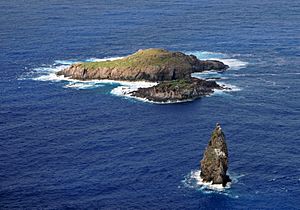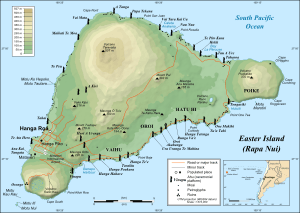Motu Nui facts for kids
Motu Nui means large island in the Rapa Nui language. It is the biggest of three small islands located just south of Easter Island. It is also the most western point in Chile and all of South America.
All three of these small islands are home to many seabirds. Motu Nui was very important for an old island religion called the Tangata manu ("Bird Man") cult. This religion was practiced between the time of the moai statues and when Christianity arrived on the island. Motu Nui is actually the top of a huge underwater volcano. It covers about 3.9 hectares of land. It is also one of the islands closest to Point Nemo, which is the farthest place from any land in the ocean.
Contents
What is Motu Nui?
Motu Nui is the largest of several small islands near Easter Island. It is a volcanic island, meaning it was formed by a volcano. Most of the volcano is actually hidden under the sea. Only its very top sticks out of the water.
Other Nearby Islands
The word Motu means "island" in the Rapa Nui language. Besides Motu Nui, there are two smaller motus nearby:
- Motu Kao Kao: This is a tall, thin rock that sticks out of the sea. It is about 20 meters (65 feet) high.
- Motu Iti: This is another small island located very close to Motu Nui.
The Bird Man Competition
The "Bird Man" cult had a special yearly competition. The goal was to find the very first egg of the manutara, a type of bird called a sooty tern. This important event started on Motu Nui.
The Race for the Egg
- Waiting for the Egg: Young men called Hopu, who represented different families, would wait on Motu Nui. They waited for the sooty terns to lay their first eggs of the season.
- The Swim Back: The Hopu who found the first egg would quickly swim back to Easter Island. This was a dangerous swim, as there were many sharks.
- Climbing the Cliffs: After swimming, they had to climb the steep cliffs up to a village called Orongo.
- Presenting the Egg: Once at Orongo, the Hopu would present the egg to their sponsor. This happened in front of important judges.
The Tangata Manu Title
The person whose Hopu brought back the first egg became the Tangata manu, or "Bird Man." This title gave them great power on the island for a whole year. The winning family also gained special rights. They could collect eggs and young birds from the small islands. Sadly, many Hopu were hurt or even died during this dangerous competition. They could be attacked by sharks or fall from the cliffs.
Exploring Motu Nui
Scientists explored Motu Nui in 1914 during the Routledge expedition. They found that six other types of seabirds nested there, in addition to the sooty terns. They also explored two caves on Motu Nui.
The Caves of Motu Nui
- One cave was where the Hopu used to stay while waiting for the first egg.
- The other cave once held a small Moai statue called Moai Maea, which means "The Boundary of the Land." This statue was later moved to the Pitt Rivers Museum in Oxford, England.
Motu Nui Today
The Bird Man competition stopped a long time ago, with the last one happening in 1888. However, people still visit the beautiful Motu islands today. Many tourists take small boat trips from Hanga Roa, which is the only town on Easter Island.
The waters around Motu Nui and Motu Kao Kao are amazing for scuba diving. Divers from all over the world love to explore this area. In the past, these waters had many sharks. Now, they are much safer for swimming and diving. This is mostly because of too much fishing in the area.
See also
 In Spanish: Motu Nui para niños
In Spanish: Motu Nui para niños



